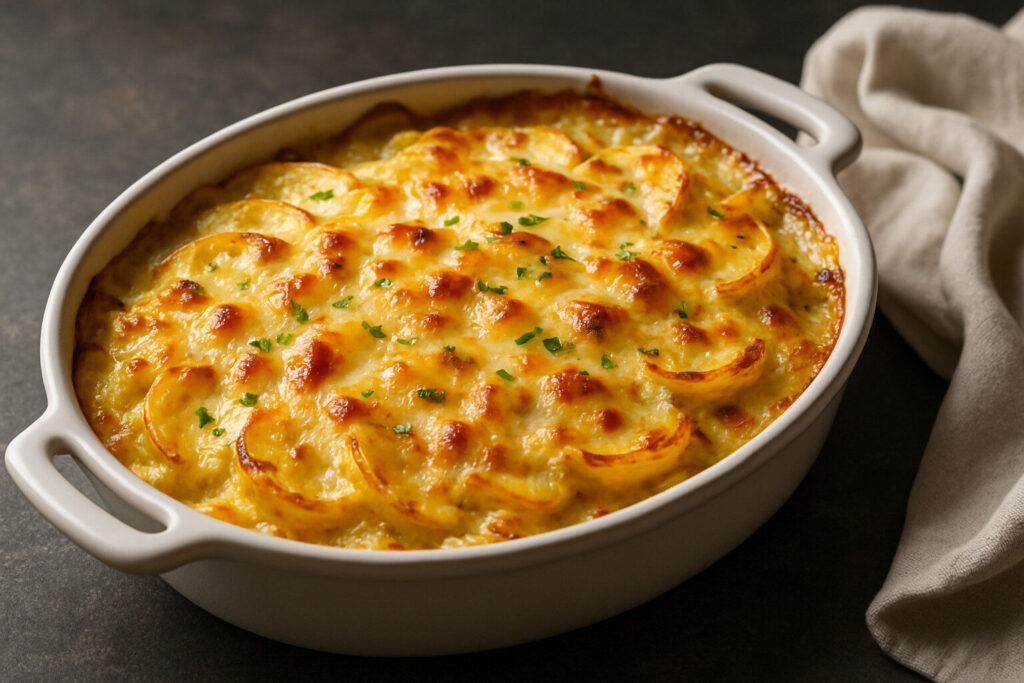
A gratin lives or dies by its cheese. Whether it is potatoes baked in cream, cauliflower under béchamel, or a simple pasta gratin, the layer of cheese on top must deliver two things at once: meltability and browning. The right cheese forms a golden, slightly crisp crust that seals in moisture and adds rich aroma. While mozzarella or cheddar may be familiar, other cheeses such as Gruyère, Comté, or aged Gouda can bring far more complexity.
How Cheese Behaves in Gratins
Gratins rely on a combination of fat and proteins in the cheese that caramelize when exposed to oven heat. Cheeses that melt evenly and have the right balance of moisture are ideal. Gruyère and Comté, both alpine cheeses, create a smooth blanket that browns attractively. Cheddar provides stronger tang but can release oil if used in excess. Mozzarella melts well but does not brown as much unless combined with Parmesan. Aged cheeses, grated finely, improve browning thanks to their lower moisture content.
The technique also matters. Cheese is usually sprinkled over the top of the dish during the last stage of preparation, just before baking. Some recipes mix cheese into béchamel or cream layers for binding, then finish with another layer on top for crust. In either case, balance is essential: too little cheese leaves the surface pale, while too much creates grease pools.
Matching Cheese to Gratin Ingredients
Potato gratins, such as gratin dauphinois, benefit from nutty cheeses like Gruyère, Comté, or Emmental, which complement the starch and cream. Vegetable gratins, for example cauliflower or zucchini, can handle sharper cheeses like cheddar or taleggio for contrast. Pasta gratins often combine mozzarella for stretch with Parmesan or Grana Padano for browning. Fish gratins call for lighter cheeses such as fontina or ricotta salata, which enhance without overwhelming. Meat-based gratins, rich in fat and flavor, stand up to strong cheeses like aged Gouda or even blue cheese in small amounts.
Intense and Neutral Options
Neutral gratin cheeses include mozzarella, Emmental, and young gouda. They melt evenly and let the other ingredients shine. Intense cheeses — Gruyère, taleggio, or blue cheese — add distinctive aroma but must be used carefully to avoid dominating the dish. The most effective approach is often a blend: a neutral cheese for body and stretch, plus a small amount of an intense cheese for flavor depth.
Exquisite Gratin Cheeses
Certain cheeses make a gratin unforgettable. Gruyère is the classic, with nutty sharpness that browns perfectly. Comté offers a similar alpine quality with slightly more sweetness. Taleggio or Fontina introduce creamy richness that pairs well with mushrooms or root vegetables. A sprinkle of Parmigiano Reggiano or Grana Padano adds crunch and umami. Even smoked scamorza can turn a simple potato gratin into a rustic dish with smoky depth.
Cost and Nutrition
Gratin cheeses vary in price. Mozzarella and Emmental are affordable and widely available, while Gruyère, Comté, or Taleggio belong to higher price ranges. Nutritionally, gratins are calorie-heavy dishes by nature, with cheese adding significant fat and protein. A topping portion of 40–80 g per serving is typical, though aged cheeses require less volume to deliver flavor.
Comparative Cheese Table
| Cheese Type | Melting & Browning | Flavor Profile | Best Gratin Pairings | Cost (approx.) | Nutrition Notes |
|---|---|---|---|---|---|
| Gruyère | Excellent melt, browns well | Nutty, sharp | Potato, onion, root vegetables | High | High protein |
| Comté | Smooth melt, caramelizes | Sweet, nutty | Potato gratin, creamy vegetables | High | High fat |
| Cheddar | Strong melt, oily if overused | Tangy, sharp | Cauliflower, broccoli gratin | Medium | High calorie density |
| Mozzarella | Melts evenly, low browning | Mild, creamy | Pasta gratins, mixed with Parmesan | Low–medium | Moderate fat |
| Parmesan (aged) | Grates finely, crisps well | Salty, umami | Topping for all gratins | Medium–high | High sodium |
| Emmental | Melts gently, mild browning | Nutty, mild | Potato, vegetable gratins | Medium | Balanced fat/protein |
| Taleggio | Creamy melt, aromatic | Earthy, pungent | Mushroom or mixed veg | High | High fat |
| Smoked Scamorza | Stringy, browns lightly | Smoky, savory | Rustic potato gratin | Medium | Similar to mozzarella |
| Aged Gouda | Melts slowly, browns strongly | Sweet, nutty | Meat-based gratins | Medium–high | High calorie density |
| Blue Cheese | Limited melt, strong | Sharp, salty | Accent in potato or meat gratins | Medium–high | High sodium |
Price and Nutrition Comparison (per 100 g, average values)
| Cheese Type | Avg. Price €/kg | kcal | Protein (g) | Fat (g) | Salt (g) |
|---|---|---|---|---|---|
| Gruyère | 20–26 | 413 | 30 | 32 | 1.6 |
| Comté | 20–28 | 410 | 28 | 33 | 1.7 |
| Cheddar | 10–14 | 400 | 25 | 33 | 1.8 |
| Mozzarella | 8–12 | 280 | 18 | 20 | 0.9 |
| Parmesan (aged) | 18–24 | 430 | 38 | 29 | 1.6 |
| Emmental | 12–18 | 380 | 29 | 28 | 1.5 |
| Taleggio | 18–22 | 360 | 20 | 29 | 2.0 |
| Smoked Scamorza | 12–16 | 330 | 22 | 26 | 2.2 |
| Aged Gouda | 14–18 | 356 | 25 | 27 | 2.0 |
| Blue Cheese | 16–20 | 350 | 21 | 29 | 3.0 |
(Values are approximate averages. Prices and nutrition vary by region and producer.)
Conclusion
Gratin cheese is about balance between meltability, browning, and flavor. Neutral cheeses provide the golden crust, while intense varieties add character in small amounts. Classics like Gruyère and Parmesan guarantee results, but experimenting with Taleggio, smoked scamorza, or aged Gouda can make a gratin distinctive. The right choice transforms a simple oven dish into something both comforting and refined.
